Each year in April, families, communities and people of all stripes come together to celebrate military children and applaud them for surmounting unique challenges.
The Department of Defense Education Activity (DODEA) commemorates this month with its "Purple Up!" campaign, in which people wear and display the color purple to show support for the children of soldiers. The military chose this color with the reasoning that purple combines each branch's colors into one, since the Air Force, Navy and Coast Guard all use shades of blue, the Army uses green and the Marines use red.
Month of the Military Child: A backstory
Established by former Defense Secretary Caspar Weinberger in 1986, the Month of the Military Child has since become an annual tradition for military families deployed worldwide. More than 1.7 million total force-dependent children across the globe face obstacles unlike most others their age. Wearing purple helps let them know you care.
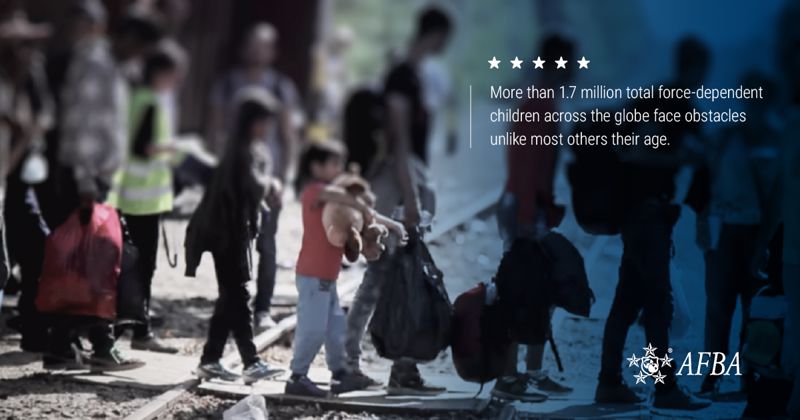
While the entire month of April is set aside to celebrate children of soldiers, the military also designates a single day during the month as "Purple Up! For Military Kids" Day. This typically falls halfway through the month, at or around April 15 each year.
Many military-related private organizations put a special emphasis on the programs they administer and provide downloadable toolkits and other resources for military children and families.
Additionally, participating Exchange restaurants worldwide will often offer free treats or other specials for any child who wears purple during the month.
How you can Purple Up! this April
Although schools and workplaces are not closed for Purple Up! Day, there are still plenty of creative ways to observe this important occasion. Many military bases and communities celebrate with special events, such as contests, parades, fairs and seminars all centered around the central message of supporting military children.
In addition to wearing purple throughout the month, anyone not currently stationed at a military base can consider trying some of these activities to observe the Month of the Military Child:
- Work with local schools, governments, businesses and organizations to raise awareness of this observance.
- Spread the word by using the #purpleup hashtag on social media or putting up purple flyers in community centers.
- Write a letter to your local newspaper that recognizes and celebrates military children.
- Create an award, or use one created by Blue Star Families, to let a military child know that they're awesome.
- Print out and pass around Purple Up! labels from the Military Child Education Coalition.
If you're already involved with the local schools and organizations, consider holding an award ceremony for military children. Be sure to include recognition of military children during morning announcements and have members or students tie purple ribbons around trees outside.
For more ways to celebrate our country's youngest heroes, check out these 50 additional ideas from the Military Child Education Coalition.
After a long year of uncertainty, many Americans are seeking a means to get the COVID-19 vaccination. Meeting this demand will require a momentous effort, involving a diverse range of contributors from the health care industry and beyond.
Following a request from the Federal Emergency Management Agency (FEMA), the U.S. Department of Defense (DoD) stepped in to join the fight against COVID-19. Now, the Army and National Guard are both playing a vital part in vaccine distribution.
Members of the armed forces make for ideal candidates to help in this crucially important process. Active-duty servicemembers can efficiently organize and quickly mobilize to areas in need. Plus, the many specialized skill sets found among soldiers are extremely useful for managing a complex and multi-faceted mission like mass vaccine distribution.
Servicemembers' role to date
The National Guard has already activated more than 20,000 servicemembers and military medical personnel to assist with COVID-19 response, reported Military.com. Some of the jobs active-duty forces are performing include administering vaccines, issuing health assessments and guiding the public through the vaccination process.
In many instances, a dual-status commander is involved to coordinate and oversee emergency response missions. This allows different military components, such as the Army and National Guard, to establish a single chain of command. The dual-status commander can then provide direction and facilitate communications among all involved servicemembers, as well as federal, state and local government agency personnel.
Where are servicemembers helping out?
All across the country and U.S. territories, active-duty servicemembers are doing their part to help with vaccine distribution.
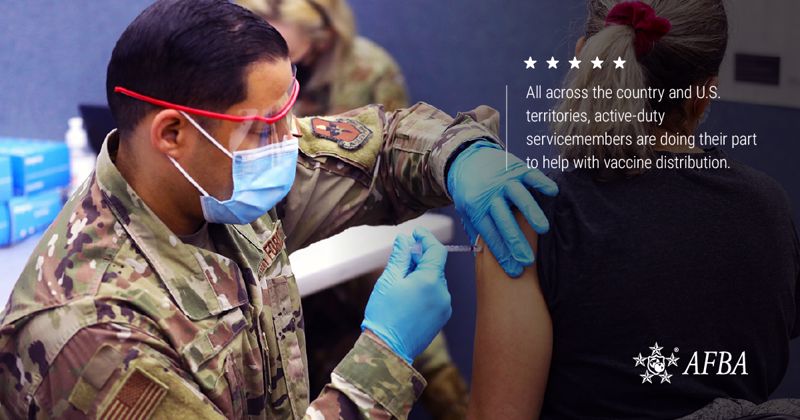
The Army sent 200 soldiers from the storied 101st Airborne Division to the United Center in Chicago, Illinois to help with vaccine distribution as part of the DoD's COVID-19 response operation. These soldiers are assigned to the 426th Brigade Support Batallion's 1st Brigade Combat Team.
"The 101st has a long history of answering our nation's call, which at times has been to support civil authority here within the U.S.," explained Lt. Col. Derek Di Bello, the battalion commander. "It is a mission we will take on with the same focus and energy that we would any task given to us."
In Pueblo, Colorado, approximately 140 soldiers with the 2nd Stryker Brigade Combat Team, 4th Infantry Division, are supporting civilian partners at the state-run, federally supported COVID-19 Community Vaccination Center.
Around 170 military personnel from the 2nd Marine Division based at Camp Lejeune in North Carolina are working with the federally run vaccination center in Memphis, Tennessee.
At the mass vaccination site located at New York City's Jacob Javits Convention Center, more than 350 New York National Guard Soldiers and Airmen, along with members of the New York Guard State Defense Force and New York Naval Militia, are working in partnership with the state's Department of Health.
These are just some of the examples of how the steadfast assistance of servicemembers has contributed greatly to delivering more than 100 million vaccinations already. While there's still have plenty of hard work ahead, if anyone is up for the job, it's our brave servicemen and women.
Firefighters must meet many unique requirements to successfully complete their duties and capably serve in their roles.
Safely navigating the dangers posed by uncontrolled blazes is perhaps the most visible and serious concern for these first responders. However, the especially important nature of the job means firefighters often follow taxing work schedules, with long shifts and weekly hours frequently exceeding those seen in other careers.
A strong bipartisan effort in Congress is working to address the scheduling demands placed on federal firefighters. These efforts include relaxing rules around trading shifts that could quickly improve work-life balance for these professionals.

Strict schedules for federal firefighters
Federal firefighters work for agencies including the Bureau of Land Management and U.S. Forest Service, along with branches of the U.S. Armed Forces, according to ZipRecruiter. They tend to fight wildfires and blazes in remote areas. Their work often necessitates especially long schedules, frequently clocking in at 24 hours per shift and 72 hours per week.
The demands placed on federal firefighters mean their free time is limited and, therefore, uniquely valuable. However, these firefighters are limited by federal rules around trading shifts to accommodate family obligations and similar needs. Many federal agencies currently avoid shift trading among firefighters because of the complexities that can arise when trades occur across pay periods, which necessitate pay adjustments and, in some cases, the provision of overtime.
Although these firefighters enjoy significant time off between working weeks, as Government Executive reported, they might be forced to miss a variety of personal events and obligations, should one fall during their time on the job.
The Federal Times explained that firefighters working for these government agencies need to use some form of leave to excuse an absence during their scheduled hours, even if they can find a colleague willing to cover that shift. This isn't a concern for municipal and state-level professionals, who already have this additional freedom in scheduling.
A bipartisan push to increase flexibility
A group of five senators, spanning both houses of the federal legislature and both major political parties, reintroduced a bill called the The Federal Firefighter Flexibility and Fairness Act in late March. This piece of legislation would allow federal firefighters to trade shifts without penalty, doing away with the requirement to use some form of leave to facilitate trades and addressing the compensation issues that currently arise.
"It's no secret that wildfires across the West are burning bigger and longer, meaning our federal firefighters work overtime, putting their lives on the line to keep our communities safe," said Sen. Jon Tester of Montana. "This critical bill gives them the flexibility they need to better balance their work and home lives, and it saves taxpayer dollars. Switching shifts is common practice among state and local firefighters — it's only common sense that our federal firefighters are able to do the same."
While the bill still needs to pass through the U.S. Capitol and White House before becoming a law, it has strong support and a strong underlying principle of fairness to first responders on its side.
The United States Postal Service counts on economical, long-lasting and easily repairable vehicles as a major part of its mission to deliver mail to all Americans. In fact, the most common mail truck used by the USPS is called the Long Life Vehicle (LLV). Produced by Grumman, a company with plenty of government contracting experience, the LLV was designed specifically with these qualities in mind.
With LLVs starting to reach an advanced age, even when accounting for their durable design, the USPS requested proposals for a new general-use mail delivery vehicle from potential providers. And, just as an experienced contractor earned the rights to produce the LLV, the new generation of USPS mail trucks will be produced by another company with plenty of history in this field.
Oshkosh to produce new USPS vehicle
Oshkosh Corporation, based in the city of the same name in eastern Wisconsin, recently won the bidding process to produce a new generation of USPS mail trucks. Car and Driver reported the relationship includes a $482 million investment to finalize the design of the new vehicle, ideally readying it for use by 2023. The mail truck, called the Next Generation Delivery Vehicle (NGDV), will represent significant steps forward in terms of design, function, safety and more.
The newest LLVs were produced in 1994, but were intended to have a 24-year useful life. The oldest vehicles still in service were made in 1987, representing 34 years of service. The replacements may come as a welcome change to mail carriers who use the LLV. A lack of air conditioning, an unreliable heater, mixed performance in severe weather and, most seriously, the fire risk, as reported by CNet, are all problems for postal employees. The new design will address these longstanding issues as well as add some important benefits, according to The Verge:
- A collision avoidance system.
- Improved ergonomics.
- Better lines of sight for the driver.
- Accommodation of both electric and gas engines, with the capability to easily convert combustion units to electric in the future.
An innovative design from a proven contractor
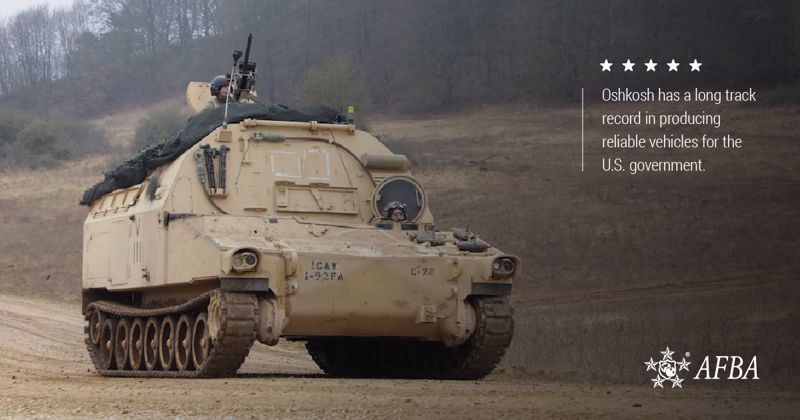
Oshkosh has a long track record in producing reliable vehicles for the U.S. government. The company's history stretches back to the early 20th century, and it began producing trucks under contract for the U.S. military in World War II, according to Forbes contributor Jim Vinoski. During the 1970s, it secured the rights to produce the M911 for the U.S. Army's tank transporter program and entered into a longstanding contracting relationship with the federal government.
Oshkosh is well known for producing a successor to the Humvee military vehicle, the Joint Light Tactical Vehicle (JLTV). The JLTV is an example of Oshkosh's ability to improve on significant flaws in vehicle design. In the case of the JLTV, the issues addressed were the vulnerability to improvised explosive devices faced by the stock Humvee, and a desire for more vehicle carrying capacity than Humvees with enhanced armor. Oshkosh has already produced 10,000 of these vehicles, and they have generally been received as reliable and effective by the servicemembers who use them.
While the risks facing postal workers and military servicemembers are vastly different, Oshkosh has proven its ability to identify limitations and defects in prior designs of equipment, then improve upon them.
Plenty of work remains to be done on the contractor's part, including opening a production plan and finalizing the design of the vehicle itself. But, if past performance is any indication, the new NGDV may well prove to be a significant improvement over the current LLV.
Two especially large and powerful winter storms swept across large parts of the U.S. in February 2021. The storms' widespread effects had an especially harsh impact in Texas, a state unaccustomed to severe cold, ice and snow. As is so often the case in adverse events, first responders across Texas played a critical role in providing emergency services.
Power outages across the state and broader region affected millions of Texans. By February 12, before the second storm hit, Texas had already suffered more than 1,000 car crashes due to slippery, hazardous roads, according to Dallas-Fort Worth NBC affiliate KXAS.
Time magazine reported that many factors related to the storms, such as rolling blackouts and differences in figures reported by various sources, made it hard to land on the exact number of impacted residents. However, Time offered an educated guess that about 15 million people were without power at various points during and after the storm. The federal government quickly made a Federal Emergency Declaration to facilitate the provision of safe places to shelter and access to basic resources.
With so many dangerous elements in play — cold temperatures, snow and ice on roads and many people without power, heat or access to potable water — emergency responders fielded an incredibly large number of calls for help.
First responders rise to the call of a state in crisis
Dallas-based ABC affiliate WFAA reported that, in the North Texas region, first responders and dispatchers received far more requests for assistance than they had during any other emergency in the previous 10 years. In the city of Wylie, the population of just under 50,000 residents made about 200 calls to first responders on an average day. During the week when the second major winter storm swept across the Lone Star State, that number rose to about 1,200 calls — a staggering 500% increase.
This drastic jump in the need for emergency services is reflected in the selfless actions taken by so many first responders in Texas. In Wylie, Julia Maschmann, an experienced dispatcher, slept in the office, ate in the shared kitchen of the city's Public Safety Building and did her laundry at machines inside the city jail — all so she could stay on the job.
"You don't leave your people, you help your people," Maschmann told WFAA.
KXAN, a Fox affiliate located in Austin, reported that Kevin Horton, a fire specialist with the city's fire department, worked 120 hours in a row during the extended emergency. Overall, Austin's fire department fielded more than 5,500 requests for assistance as the storm hit the area and in its aftermath. That included playing a key role in rescuing thousands of doses of COVID-19 vaccine that could have otherwise spoiled or gone to waste, due to the severe disruption caused by the hazardous conditions.
First responders across the state drew on their knowledge, skills and past experience to respond to calls in uniquely treacherous conditions and organize their available resources in the most efficient manner possible, to provide as much assistance as they could. In terms of experience, past work in colder climates paid off for one fire department. The city of Killeen, in central Texas, had recently hired James C. Kubinski, a veteran Chicago firefighter, as its department chief, according to the Killeen Daily Herald.
"I had experienced the increased call volume and broken water pipes associated with a deep freeze and thaw more than once, so I knew what was going to be coming," Kubinski told the Herald. "There was no hesitation when the captains and battalion chiefs asked for approval to implement a plan they developed that included increased staffing and adding booster trucks as quick response vehicles. Larger fire apparatus were only put on the street for more major incidents."
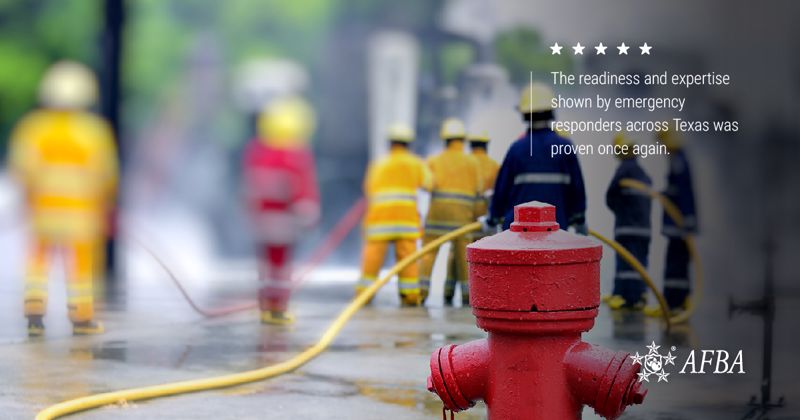
The readiness and expertise shown by emergency responders across Texas was proven once again. These professionals are community heroes and they play absolutely crucial roles in trying times.
As fate would have it, 2020 marked the 100th anniversary of the first certified respirator — as well as a major surge in awareness around this essential piece of protection.
While the COVID-19 pandemic has brought more attention to the value of face coverings in helping reduce disease transmission, various types of personal protective equipment (PPE) have supported health care professionals and emergency responders in the workforce for centuries.
Here is a look at the evolution of these PPE essentials and milestones that have led to advancements that keep the first responder communities safe today.
Early face coverings were intended to offer protection from toxic chemicals
The history of the face mask has its origins in the first century CE, according to the Centers for Disease Control and Prevention (CDC). The Roman philosopher Pliny the Elder relied on animal bladder skins to avoid inhaling toxic minerals like cinnabar that were popular in the decorative arts. Leonardo da Vinci suggested damp cloths for protecting the nose and mouth from similar risks.
It was clear to Bernardino Ramazzini that toxic agents were occupational hazards in need of superior protective equipment to address them. The observations in his 1700 publication, "De Morbis Artificum Diatriba" (Diseases of Workers), made Ramazzini the father of occupational medicine.
Medical discoveries led to improvements in filtration technology
Miasma theory, which incorrectly identified the source of epidemic diseases as odors from rotting organic material, led 17th-century "plague doctors" to wear beak-like masks filled with fragrant herbs. These coverings were intended for protection against the noxious "bad air" that was believed caused disease transmission. Throughout the 18th and 19th centuries, however, researchers made new discoveries about the nature of airborne particles and their impact on respiratory health. A series of particulate respirator designs relied on early filtration systems to keep the nose and mouth safe from smoke and harmful gases.
20th-century crises underscored the need for respiratory protection
As the 20th century unfolded, the population was woefully unprepared for the respiratory risks to come, on the battlefield and on the home front. Aggressive chemical warfare strategies of World War I caused nearly one-third of casualties since troops in combat were not equipped with respirators. As a result, during World War II, servicemembers and civilians were urged to carry and wear gas masks.
In response to high fatality rates among mineworkers and the 1918 influenza pandemic, the newly formed United States Bureau of Mines (USMB) launched the first respirator certification initiative in 1919. The Gibbs respirator — a "closed-circuit self-contained breathing apparatus" — became the first certified model under this program the following year, according to the CDC.
The formation of the Occupational Safety and Health Administration (OSHA) in 1970 transformed earlier respiratory protection recommendations into requirements across industrial settings.
1990s-2010s events led to further PPE research and standardization
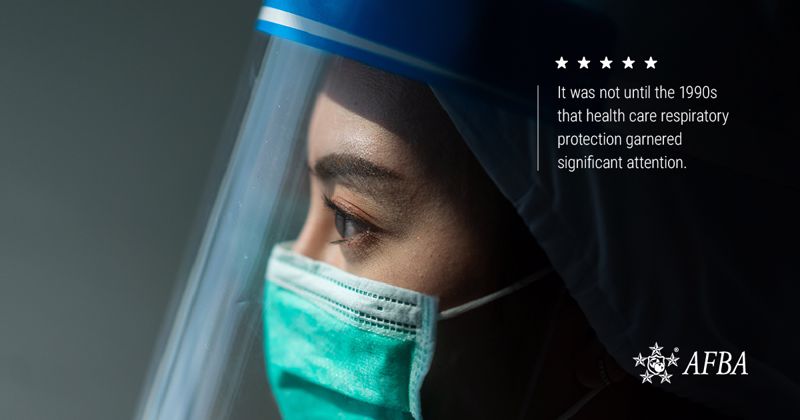
It was not until the 1990s that health care respiratory protection garnered significant attention. A tuberculosis outbreak sparked the adoption of air-purifying respiratory equipment as a safer alternative to surgical masks. The 9/11 attacks also drew attention to other first responders' PPE needs, as firefighters suffered from ineffective respiratory protection during rescue and recovery efforts. By the time the Ebola epidemic reached the U.S. in 2014, emergency response professionals were urged to wear the N95 respirator.
Each of these crises has led to significant scientific advancements, tighter regulations and heightened awareness of the importance of PPE. Researchers continue to make new discoveries amid the COVID-19 pandemic, which will undoubtedly help protect first responders from the respiratory risks of the future.
When signing the Buy America executive order in late January, President Biden discussed his administration's push to transition government fleets to electric vehicles (EVs) of American origin. During the press conference, Biden situated this initiative as part of the administration's "Build Back Better" recovery plan and efforts to modernize infrastructure, according to CNBC.
Here's a look at the current state of fleet manufacturing and use, as well as what contractors can expect moving forward.
Government agencies account for 645,000 vehicles
As Biden explained during the press conference, "The federal government also owns an enormous fleet of vehicles, which we're going to replace with clean, electric vehicles made right here in America by American workers, creating millions of jobs."
According to the U.S. General Services Administration's 2019 Federal Fleet Report, the federal government owns and operates about 645,000 vehicles, which consume 375 million gallons of gasoline and diesel fuel per year. Of these vehicles, about 225,000 are operated by the post office and 173,000 are for the military.
New focus on Made-in-America fleets and contract opportunities for small businesses
President Biden aims for EV "net zero emissions" fleets that are produced using American parts and labor.
The administration noted that, in recent years, the federal government "spent nearly $300 million on foreign engines and on vehicles, instead of buying American vehicles and engines from American companies, putting Americans to work."
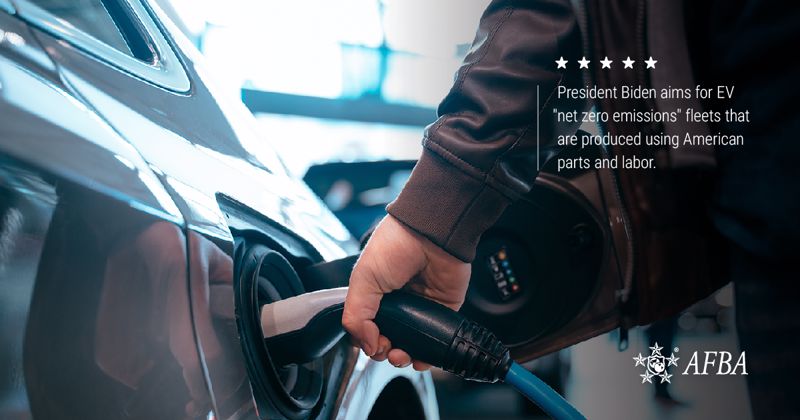
To ensure government spending supports U.S. businesses, the Buy America executive order included appointing a new Director of Made-in-America at the White House Office of Management and Budget. Part of the director's purview will be to support more transparent and participatory procedures for U.S. businesses.
For instance, the procurement process is expected to carefully assess and publicize all waiver requests that favor foreign parts and products. This way, American manufacturers, including small businesses, can have the opportunity to offer up their services.
Under the current component requirements, vehicles manufactured for government use are intended to contain 50% American parts. Biden said new initiatives would close existing loopholes and ensure that the highest-value components — steel, engines, glass and so forth — are manufactured domestically.
An 'avalanche' of new EV offerings and auto jobs expected
This push toward electric fleets comes as part of Biden's clean energy mission to create 1 million new jobs across the automotive industry and "position America to be the global leader in the manufacture of electric vehicles and their input materials and parts."
This announcement is promising for the few EV manufacturers in the U.S. like Tesla, Lordstown and Rivian as well as longstanding companies like General Motors, Nissan and Ford, which are actively pivoting to invest in EV production. But industry experts forecast opportunities for U.S. businesses beyond these big-name companies.
"The current [EV] offerings are pretty slim, but the industry's about to unleash an avalanche of new product, and a lot of it built in North America," Kristin Dziczek, vice president of industry, labor and economics at the Center for Automotive Research, said in an interview with CNBC. "Just about every U.S. plant is going to have a hybrid or electric product."
Nearly 100 years ago in 1926, Carter G. Woodson, a scholar of African American history and the African diaspora, set aside a week in February for the recognition and remembrance of Black history. Fifty years later during the U.S. bicentennial, President Gerald Ford extended this into the federal observance now known as Black History Month.
Ford urged the nation to "seize the opportunity to honor the too-often neglected accomplishments of Black Americans in every area of endeavor throughout our history."
This February, we are honoring the accomplishments of Black servicemembers in the armed forces by sharing a timeline of several notable firsts that contributed to key turning points in military history, from 1770 to the present.
1770: Crispus Attucks, first American casualty in the Revolutionary War
Crispus Attucks, a former enslaved person and dockworker of African and Native American descent, joined a group of Boston patriots in protest against British soldiers. He was fatally shot, becoming the first American to sacrifice his life in defense of the colonies. Tens of thousands of Black soldiers would ultimately serve in the Revolutionary War. Attucks was honored at the time of his death and would later become a symbol for the abolitionist movement.
1863: William Carney, first Black Medal of Honor recipient
William Carney enlisted in the first Black unit recruited for the Union Army — the 54th Massachusetts Infantry Regiment — where he served alongside 40 other Black service members. When the unit's color guard was shot during battle, Carney sustained enemy fire and nearly lost his life in an effort to ensure that the American flag did not touch the ground. His moving and valiant patriotism was acknowledged in 1900 with the Congressional Medal of Honor. As of 2020, 92 remarkable Black servicemembers have since been awarded the Medal of Honor.
1917: Harlem Hellfighters, first all-Black combat unit to serve overseas during WWI
During the First World War, the 369th Infantry regiment — known as the Harlem Hellfighters — became the first Black combat unit to serve overseas. The U.S. did not offer combat roles to African Americans, so the unit was assigned to the French Army. The Hellfighters served in the trenches for 191 days straight without getting captured or ceding any ground, earning them the Croix de Guerre.
1946: Della Raney, first Black woman to serve as an Army major
In 1941, nursing graduate Della Raney became the first Black nurse to serve as a lieutenant in the U.S. Army Nurse Corps. As the Second World War continued, Raney continued as a trailblazer in the Army, marking new firsts with each promotion. She was promoted to captain in 1944 and major in 1946. Maj. Raney continued her Army service until her retirement in 1978.
1941: Tuskegee Airmen, first Black military aviators
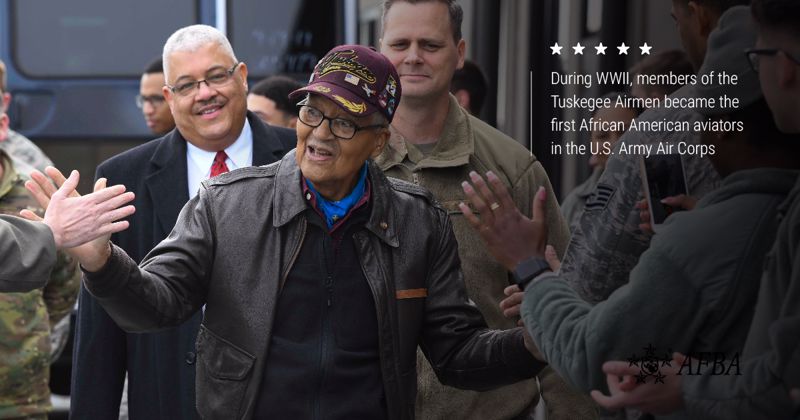
During WWII, nearly 1,000 members of the Tuskegee Airmen trained in the Jim Crow South and became the first African American aviators in the U.S. Army Air Corps, the precursor to the U.S. Air Force. They never lost an escorted plane to enemy forces despite completing hundreds of escort missions and more than 15,000 sorties. The Tuskegee Airmen earned 150 Distinguished Flying Crosses and are being recognized in 2021 with a commemorative quarter inscribed, "They fought two wars."
1989: Colin Powell, first Black Chairman of the Joint Chiefs of Staff
When he was appointed as the Chairman of the Joint Chiefs of Staff by President George H.W. Bush, Colin Powell took on the highest-ranking military position in the Department of Defense and became the first African American and youngest person to do so.
Present day
According to the latest data, roughly 224,000 servicemembers and about 2.1 million military veterans are Black Americans. These brave men and women have continued making a mark on military history thanks to their courageous contributions and service to the nation.
In the Valentine's Day spirit, we're tracing the history of "sweetheart jewelry," which became widely popular during the Second World War.
Traditionally given by a soldier heading off to war to a loved one at home, a piece of sweetheart jewelry was both romantic and patriotic in nature. Today, these items are considered collectible pieces of our nation's past.
Sentimental jewelry to remember soldiers during times of war
As the Cooper Hewitt museum explains, the custom of gifting sweetheart jewelry dates back to World War I. However, it became even more popular during World War II, when countless couples and families were separated as soldiers left home to fight overseas.
Sweetheart jewelry was most commonly exchanged between romantic couples. But fathers, brothers and sons also left family members with these tokens in their absence. Women purchased their own sweetheart jewelry, too, either to remember a certain soldier or show support for the nation's forces as a whole.
Wherever these sentimental items came from, their owners wore them proudly and passionately. Women wore brooches to keep their family and country close to the heart. They tucked pictures of the soldiers they missed into treasured lockets and they wore their hearts on their sleeves in the form of bracelets.
Patriotic colors and imagery permeated jewelry design
While hearts were a common theme, sweetheart jewelry was not only romantic in design; it was also highly patriotic. Many of these items featured military insignia and other icons related to a loved one's branch of service. Others included the American flag or details featuring stars and stripes.
An all-American red, white and blue color scheme was also typical of sweetheart jewelry. Additionally, a library of patriotic imagery, ranging from the eagle and the victory "V" to Uncle Sam's top hat, can be seen in jewelry from the WWII period. Phrases like "Loose Talk Can Cost Lives" and "Remember Pearl Harbor" also made their way into pins and pendants.
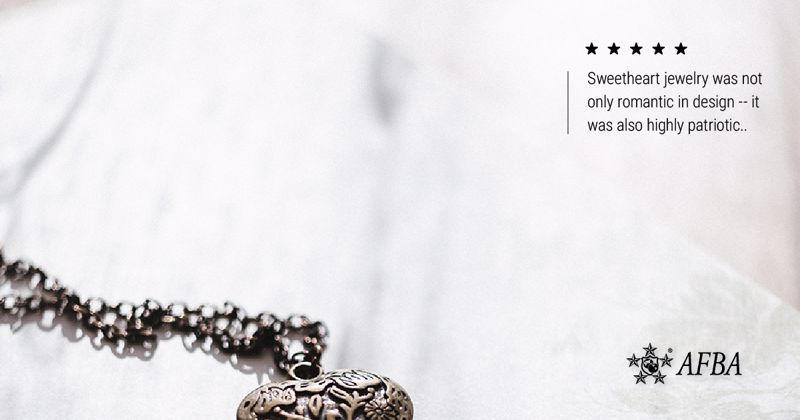
As the National Museum of American History explains, sweetheart jewelry became quite fashionable during WWII. Under rationing rules, new clothes and accessories were hard to come by. Women were urged to make do with what they had. Sporting a sparkling brooch was a welcome way to enliven an old dress collar and show one's support for the nation.
Meaningful jewelry made of modest materials
Sweetheart jewelry did not need to be made of fine, expensive materials like rubies, diamonds or sapphires set in gold. Instead, many Americans exchanged items made of gilded base metals set with sparkling glass crystals, rhinestones and imitation gemstones.
When access to certain base metals was restricted during rationing, jewelers turned to sterling silver. As the Cooper Hewitt museum notes, this forced one manufacturer to triple its jewelry prices — but consumer demand didn't falter.
Other materials such as enamel, wood, mother-of-pearl, shell, and celluloid and Bakelite plastics were also often found in sweetheart jewelry. Some soldiers handcrafted their own sweetheart jewelry items, carving bullets, coins, casings and other metal objects into sentimental adornments.
Sweetheart jewelry inspires a new generation of Americans
According to Collectors Weekly, wartime sweetheart jewelry is now highly collectible: "Sweetheart jewelry is among the most affordable of home-front collectibles, even though the prices have risen in the last 10 years. That's because these items have been growing in popularity with both military and jewelry collectors, as well as Americans who yearn to connect to veterans of past wars and express their patriotism."
Sweetheart jewelry has also inspired a new generation of jewelry makers, including Jessica Gibson, a former Supply Sergeant of the U.S. Army Reserves. In response to the COVID-19 pandemic, Gibson created a sweetheart jewelry-inspired collection.
As she explained in a news release, "1940s fashion and history have captivated my heart over the past few years. Considering all the challenges we are currently navigating, remembering that we've collectively navigated more challenging times has given me hope that together we'll get through this, as we've done in the past. Working on this collection has been therapeutic and inspiring as I designed it with the intention of providing the wearer with a sense of strength and comfort."
The U.S. Army recently announced several major updates to Army Regulation 670-1, Wear and Appearance of Army Uniforms and Insignia, slated to go into effect Feb. 24, 2021. Here is a look at some of the key revisions as well as the reasoning behind the changes.
A people-first approach
As part of the Army's Project Inclusion, instituted in mid-2020, the topics of hair and grooming have come under question. Current guidelines have been critiqued for being discriminatory against various groups, including Black Soldiers and women in the Army. The revised regulations aim to minimize racial bias and promote a more inclusive approach.
"The Army must continue to put people first by fostering a culture of trust that accepts the experiences and backgrounds of every Soldier and civilian," said Deputy Chief of Staff for Personnel, Lt. Gen. Gary Brito, in an announcement. "Our diverse workforce is a competitive advantage, and the Army must continue to offer fair treatment, access and opportunity across the force."
Newly authorized hairstyles are intended to promote healthy, natural hair for all Soldiers
As for hair, a wider range of styles will now be accepted. Previously, women were required to style their hair in a low, tight bun. As this can lead to hair loss, the updated regulations specify that styles such as long ponytails and braids may be worn. They can be tucked into a Soldier's uniform to prevent snagging, and are expected to improve the fit of combat helmets.
"In an effort to stop hair damage and loss stemming from hairstyles like the bun, the Army approved healthier hairstyle options that are more inclusive of various natural styles," explained Sgt. Maj. Mark Anthony Clark.
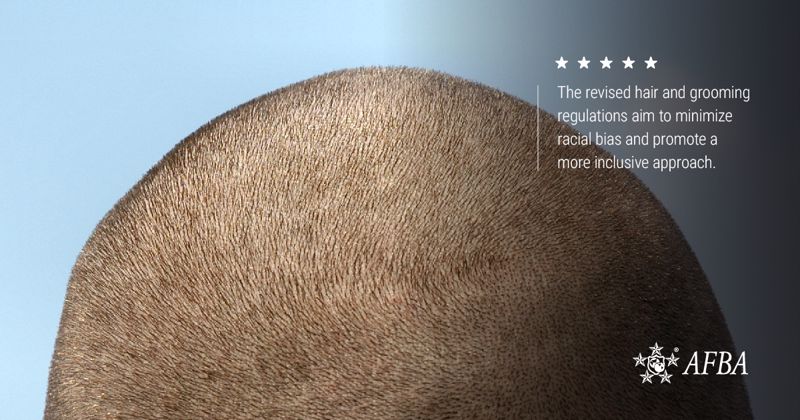
Furthermore, the Army has loosened strict requirements related to cornrows, braids, twists and locks which may be worn by Black servicemembers. Soldiers were previously permitted one such style at a time, with individual sections limited to half an inch in width. The width requirement has been removed, and Soldiers may now opt for more than one of these styles at a time.
Highlighted hair that maintains a natural appearance will also be permitted, although vibrant, artificial hues like blue, green and purple are still not authorized. A Soldier's dyed or bleached hair color "doesn't necessarily have to be a color that is typically seen on a certain ethnic group," explained Master Sgt. Quintana Mitchell.
In an attempt to improve cultural sensitivity within the grooming regulations, words describing particular styles, such as "Mohawk" and "Fu Manchu," are also being revised in favor of verbiage that is less offensive and more descriptive. New images have also been produced to provide clearer detail about the authorized and unauthorized styles.
Additional grooming guidelines support self-expression and safety
Once the new regulations are in place, simple gold, silver or diamond stud earrings will be authorized for women in most non-combat contexts. Additional lipstick and nail polish colors are being added to the list of accepted cosmetics for women. Male Soldiers will also be permitted to wear clear nail polish, either as a grooming choice or in order to protect their nails while working with rough tools and harsh chemical agents.
"Our identity is important," said Sgt. Maj. Brian Sanders in an Army announcement. "If we care about people first and the Soldier as a whole, we have to care about the many aspects to who they are as well. This is a small, but significant change that positively impacts a considerable size of our force."
"I use the analogy, 'If you look good, you feel good — and if you feel good, you perform [well]," Sanders added, explaining that this more inclusive approach to personal appearance and grooming may result in productivity improvements.

